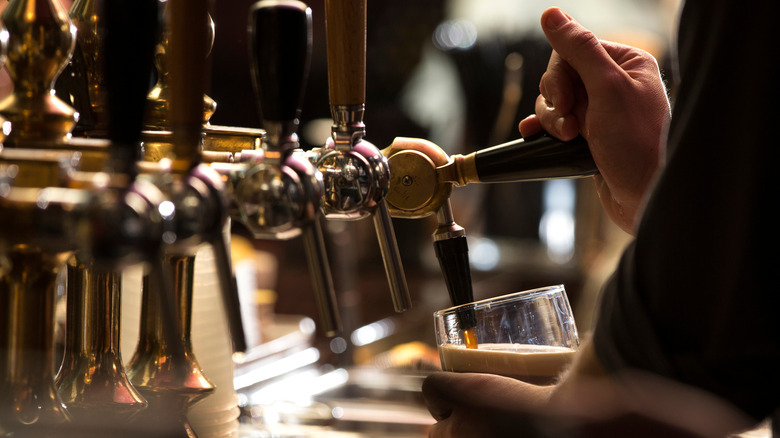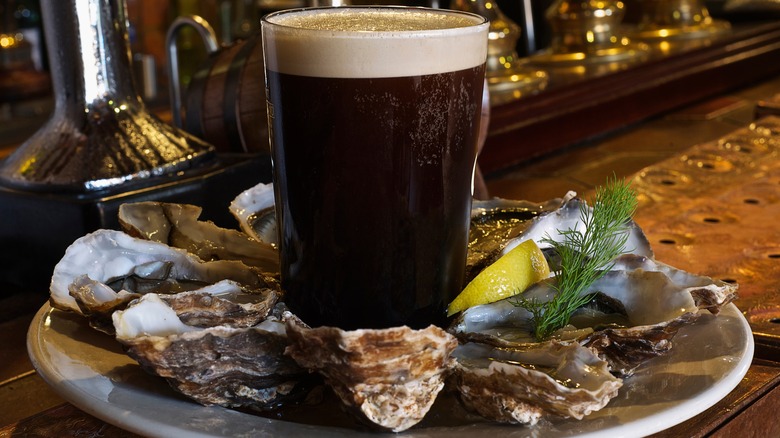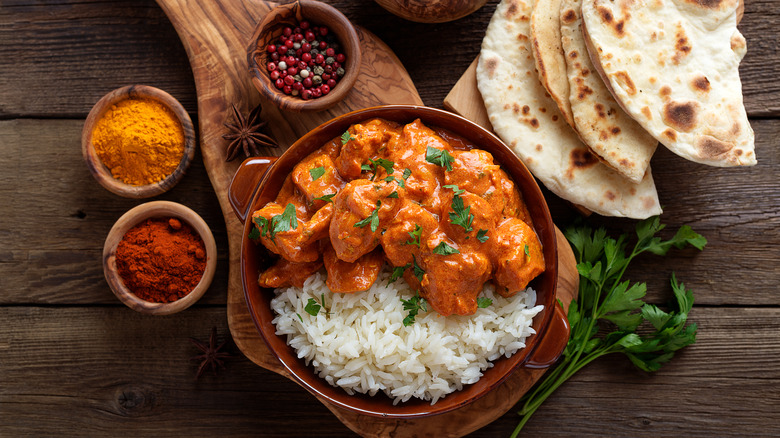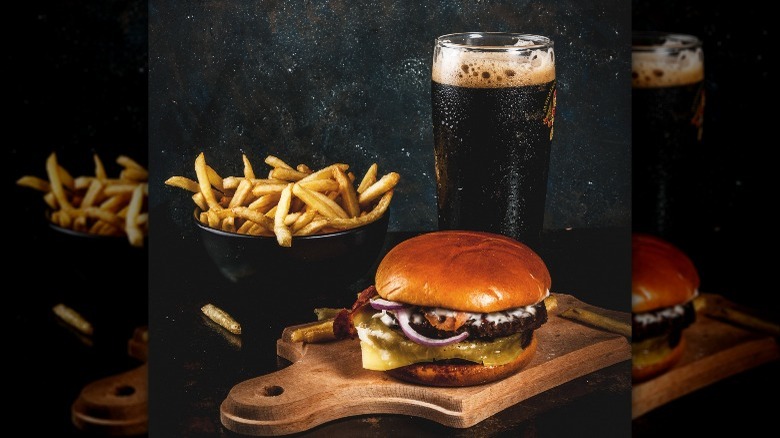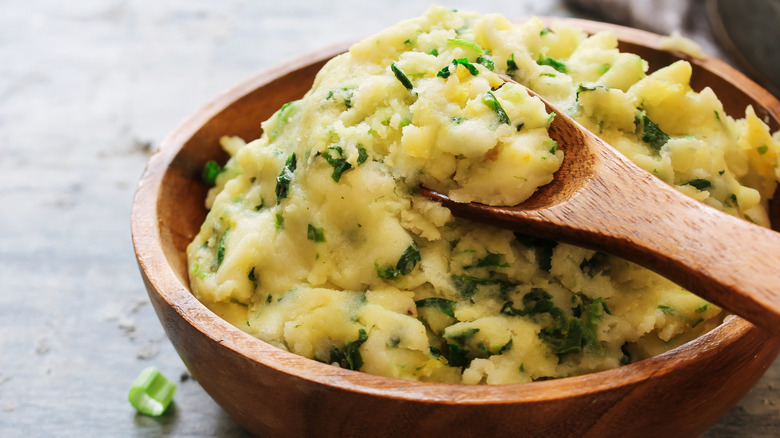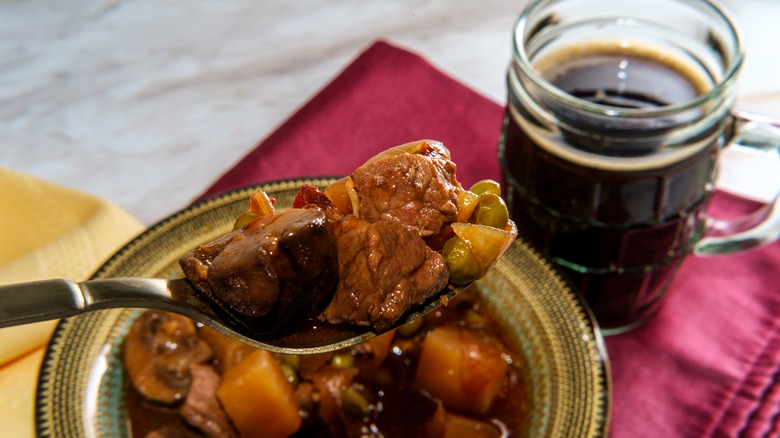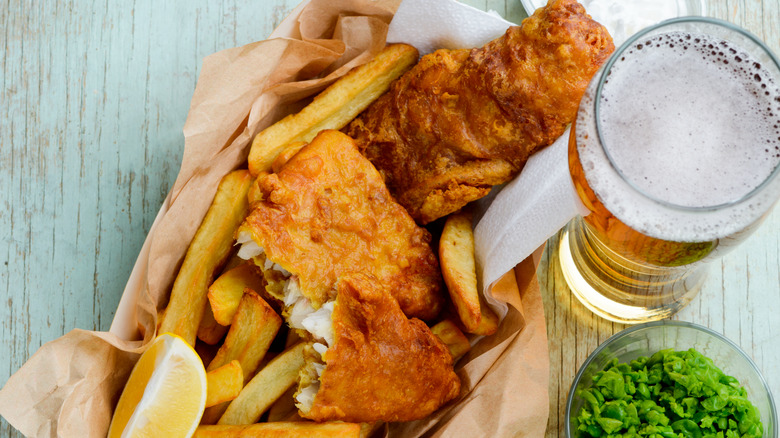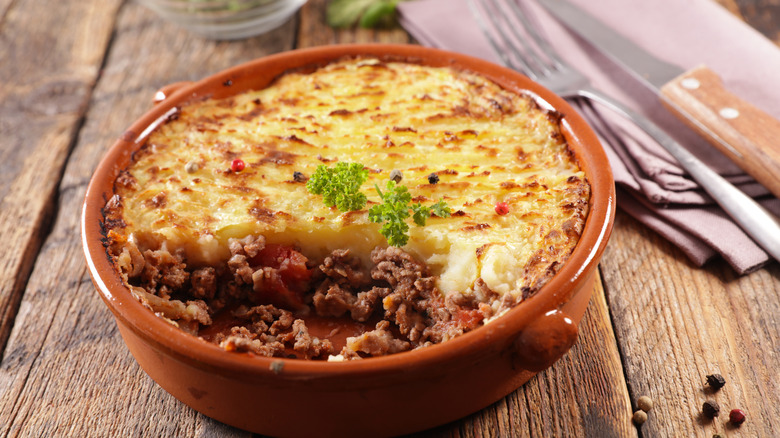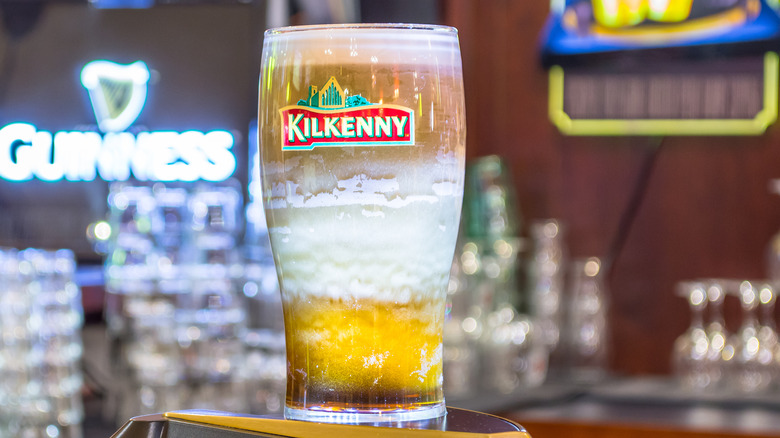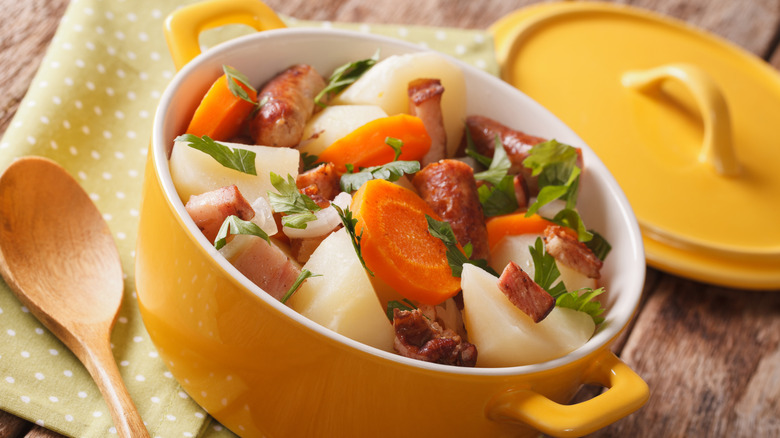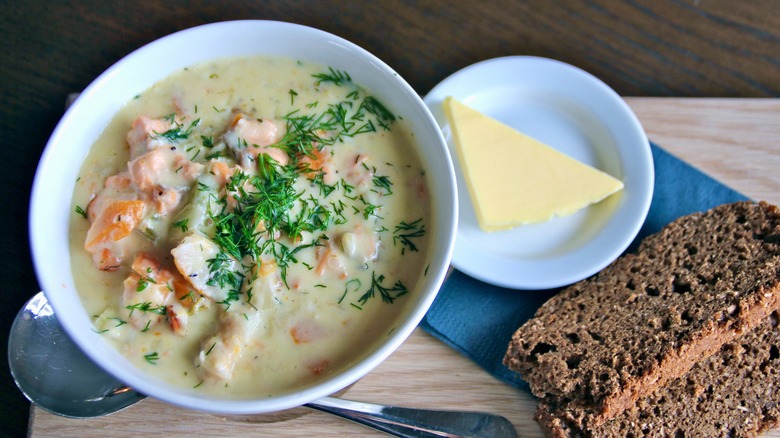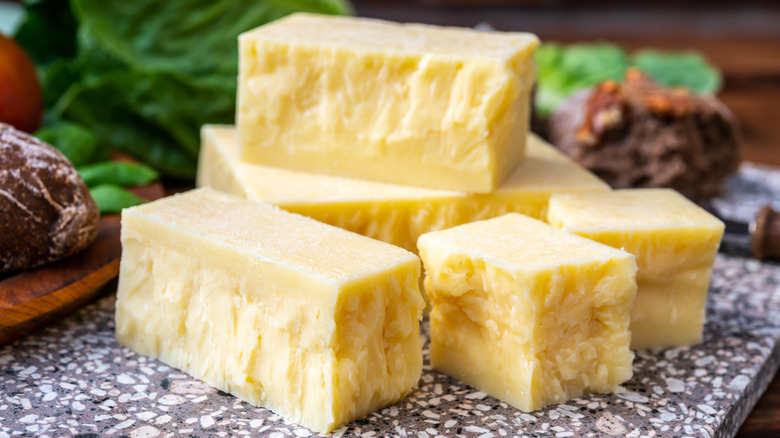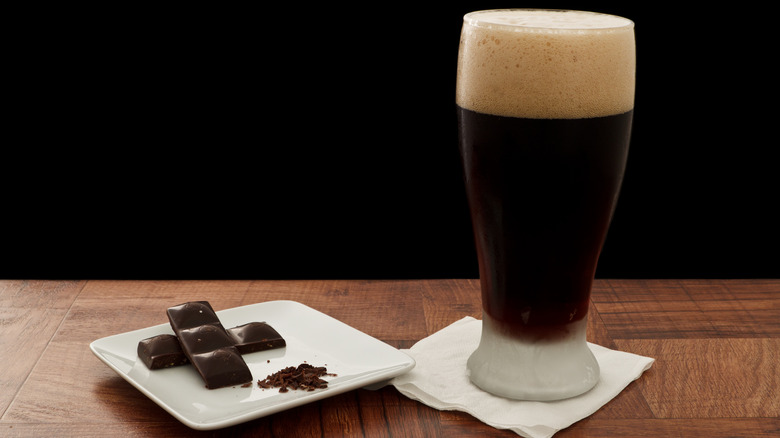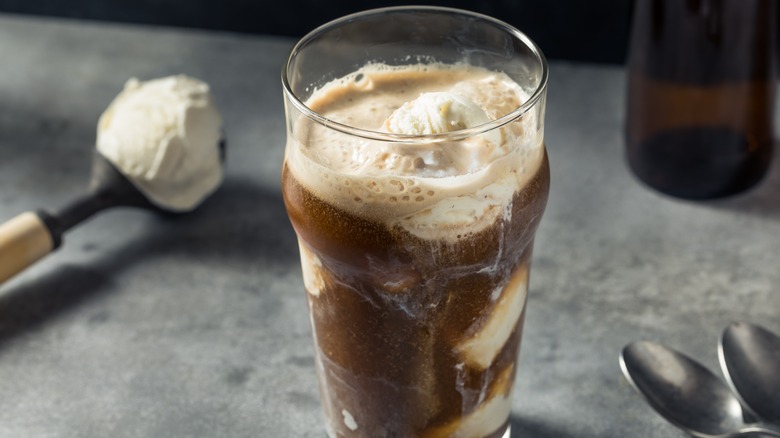The 13 Best Food Pairings For Irish Beers
From the earliest bronze age brews of herbal gruit to the worldwide success of Guinness, Irish beer has a long and storied history. While today's Irish beer scene is dominated by major breweries, many of which are operated by multinational corporations — even Irish icon Guinness is now headquartered in London — there's been a surge of microbreweries in recent decades that have popped up throughout the country, experimenting with new styles. Sadly, many of these are hard to find outside of Ireland. Still, it's the tried-and-true classic styles of Irish beer that fans around the world crave.
From Irish stouts like Guinness to cream ales such as Kilkenny, the beers of the Emerald Isle just so happen to pair beautifully with food, especially with Irish flavors. Whether you're throwing a St. Patrick's Day feast, or simply heading down to the nearest Irish pub for a plate and a pint, you can get the most out of your beer and food by trying a few of these favorite tried-and-true pairings.
1. Irish stout & oysters
You might think it sounds strange the first time you hear it, but a pint of Irish stout and raw oysters are a classic pairing. If you've never had these two seemingly disparate items together before and you're feeling skeptical, that's understandable. But if you're curious and open-minded enough to give the pairing a chance, you may be pleasantly surprised by the results.
Ireland, being an island, possesses plentiful coastal areas that are ideal for oyster cultivation — in fact, oysters have been a vital part of the diet here for thousands of years. Irish stouts didn't come around until much later, in the 1800s, and the creamy nitrogenated version that we associate with draft Guinness was only established in the last century. It's impossible to know when the first intrepid diner discovered the stout and oyster alchemy, but the unusual pairing has endured.
Why does it work? Irish stouts boast a bitterness similar to coffee thanks to their dark roasted malt. When this bitterness comes in contact with saltiness, like that of briny oysters, on our palate, the bitterness is subdued and the natural sweetness and creaminess of both the stout and the oyster are enhanced. The sensation is nothing short of perfection, especially if you're an oyster fan. Popular Irish stouts to look out for are Guinness, Beamish, and Murphy's. If you can find it, Porterhouse Brew Company's Oyster Stout is actually brewed with the mollusk's shells, making it perfect for this pairing.
2. Irish red ale & chicken tikka masala
It may not be a traditional Indian recipe, but chicken tikka masala has proved to be a legendarily popular dish throughout the U.K. and Ireland, not to mention the rest of the world. Purportedly invented by Pakistani-born chef Ali Ahmed Aslem at his restaurant in Glasgow, the relatively mild, saucy curry shows up on menus everywhere, including many Irish pubs. Perhaps that's because it pairs so well with Irish beer — especially Irish red ale, such as Smithwick's and O'Hara's.
Irish red ale is known for its pronounced maltiness which gives it a caramely sweetness, as well as a mellow roasted character that's just shy of bitterness. Hops are typically mild and alcohol is relatively low, making Irish red ale an easy-drinking beer that's pleasant to sip on with or without food. Chicken tikka masala is not as hot as many other curries, but its piquancy and layers of spice still work well by contrasting the red ale's sweet maltiness. The masala's rich yogurt and cream elements are enhanced by the beer's richness, while the tomato tang balances that out. Irish red ale can handle hotter Indian dishes, like madras and vindaloo, but tikka masala is the perfect complement.
3. Irish extra stout & burgers
Similar to a basic Irish stout, Irish extra stout showcases more body and richness as well as a stronger, more intensely bitter flavor. The deep, dark roasted notes in an extra stout, along with its full texture make this Irish beer a great match with hearty red meats, especially if they have a charred crust. A beautifully grilled or griddled burger pairs perfectly with this style of Irish beer.
The caramelized exterior of a burger patty matches up with the malty, sometimes chocolatey flavors you'll find in an extra stout while also mellowing out the strong bitter finish, making the intense beer easier to drink. The dark roasted notes in the beer echo the burger's savory notes and enhance them. This style of beer goes so well with beef, in fact, it makes a great addition to the meat itself — pour a little Irish extra stout into your burger mix to add even more dimension to the pairing.
Guinness Extra Stout is the most well-known of this type of beer, and is based on the brewery founder's original Porter recipe. O'Hara's Leann Folláin is another example of the style.
4. Irish lager & colcannon
For how integral potatoes are to Irish cuisine as we know it, the root vegetable is actually not indigenous to the island. The hearty tuber hails from the Andes, and didn't make its way across the Atlantic until the 1500s. Once it did, it became a staple of the Irish diet, where folks developed recipes like colcannon. This homey, robust dish, which has been around since at least the 1700s, consists of boiled and mashed potatoes mixed with vegetables like cabbage, leeks, or kale. It's served with plenty of butter and sometimes topped with bacon and scallions.
The creaminess of this dish pairs well with a beverage that can cut through the richness and match the vegetal, oniony notes with some bright acidity and flavors. That makes an Irish lager a perfect partner. Irish lager is balanced, crisp, and not too hoppy, making it easy to drink and pair with food. A more recent style of Irish beers, lagers weren't really brewed in Ireland until the very late 19th century, and didn't become a major deal in the country until the 1960s, when the production of Harp began. In addition to Harp, O'Hara's makes an Irish lager that boasts a stronger hop flavor, a good match for a more green vegetable-heavy colcannon.
5. Irish stout & beef stew
For as long as there's been fire and pots, there's been stew, hearty, rustic, and an easy, hands-off way to feed groups of people. Another advantage of stew is that the long, slow cooking process can turn tough hunks of meat and bland ingredients a into tender, rich, and tasty medley of flavors and textures. There's no singular recipe for Irish stew. It can vary widely depending on the ingredients on hand. Beef is commonly used as the meat component, along with potatoes, carrots, and other root vegetables like turnips and parsnips. And often, Irish stout is added to create more depth of flavor.
An Irish stew made with stout, such as this Secret Guinness Beef Stew from Boston's The Black Rose pub, pairs perfectly (as you might expect) with Irish stout. Not only does the beer echo the flavors it brings as an ingredient in the stew, but the roasted malty character matches the richness of the meaty, savory dish. Beef stew and Irish stout make for a warm, comforting duo, great on a cold rainy day, or anytime you need culinary contentment.
6. Irish pale ale & fish and chips
Pale ales in general can be among the hoppier styles of beers, which makes them somewhat tricky to pair with food. Strong hop presence in a beer can overwhelm subtler flavors, and will magnify any spice, sometimes to an uncomfortable degree if you're sensitive to heat. But Irish pale ales tend to be mellower when it comes to hop intensity compared to their American or Indian counterparts, which gives them more versatility. A classic serving of fish and chips makes an excellent pairing with Ireland's pale ales.
Bitterness balances out fat, so the deep-fried richness of fish and chips seems lighter when washed down with a pale ale. And the bright citrus notes in beer, which often exhibit lemon and grapefruit flavors, bring out the brightness in fish. This style of beer also often possesses fresh herbal and pine notes, which echo the zesty, fresh flavors of tartar sauce. Good examples of the style include the intensely aromatic O'Hara's, the strong and citrusy Heaney Irish Pale Ale, and the mellow and balanced McGrath's Irish Pale. If you don't have a nearby pub to turn to, try this recipe to make your own fish and chips with tartar sauce.
7. Irish red ale & shepherd's pie
Like many of the world's heartiest, homiest dishes, shepherd's pie likely developed out of necessity as a way to utilize leftover meat with inexpensive, common ingredients to create a filling meal. Not to be confused with cottage pie, which is made with beef, shepherd's pie, as the name suggests, is traditionally made with lamb or mutton. Vegetables like carrots and peas, along with gravy, round out the meat filling, and a thick, creamy topping of mashed potatoes creates the pie's crust. When looking for an Irish beer to pair with this comforting dish, reach for an Irish red ale.
With a beef-based cottage pie, Irish stout is often recommended, but Irish red ale is a much better fit for lamb. The meat's robust flavor reacts well with red ale's malty sweetness, which tones down its gamey intensity while enhancing the savory flavor. Both the dish and the beer are on the rich side, but there's enough crispness and a touch of bitterness on the finish of Irish red ale to balance it all out. To punch up the red ale flavor even more, follow this Irish Red Shepherd's Pie recipe which includes the beer in the gravy.
8. Irish cream ale & chicken and leek pie
Another comforting dish found throughout Ireland is the savory chicken and leek pie. A lighter alternative to shepherd's pie, but still full to the brim with satisfyingly buttery and creamy richness, this dish finds a perfect beer style match in the Irish cream ale. This style of ale is somewhat similar to a red ale in its malty character, and has a buttery, creamy texture that gives it a smooth mouthfeel. Kilkenny is the most well-known example of this style and is poured on draft using nitrogen similar to Guinness, adding to the beer's creaminess.
When paired with a chicken leek pie, the beer enhances the richness of the cream-based gravy filling and matches the buttery flavor and texture of the pastry crust. Irish cream ale is quite mild when it comes to hops and bitterness, so it won't clash with the more flavorful elements of the dish, like herbs, onion and leeks, and earthy mushrooms. Other than Kilkenny, there aren't too many widespread examples of this style, but many other countries have their own versions, such as Wexford Irish Cream, brewed in England.
9. Irish cider & Dublin coddle
The Dublin coddle is one of countless examples of the Irish people's exceptional ability to make delicious, enduring dishes out of frugality and necessity. There's no exact recipe for a coddle, but it typically consists of a combination of whatever pork products you have on hand — bacon and sausages, most commonly. The addition of vegetables heartens things up, like onions and potatoes, all stewed together in a long-simmering broth. This filling and flavorful dish can be enjoyed with a lot of beverages, but perhaps the most fitting match is an Irish cider.
Pork and apple have a great affinity for one another, creating a bright yet deeply savory combination of flavors. Herbs present in the sausage and added to the stew, such as rosemary and thyme, are amplified by the freshness of a nice crisp cider, livening up the hearty dish so it doesn't come across as too heavy. Cider can even be added to the soup itself to bring a dimension of fruity flavor. Bulmers, otherwise known as Magners outside of Ireland, is perhaps the most popular cider produced in the country. Other excellent brands include Dan Kelly's and Stonewell.
10. Irish lager & seafood chowder
With its over 3000 kilometers, or nearly 2000 miles, of coastline, Ireland is a seafood lover's paradise. From mussels, crabs, and oysters to fish like haddock and salmon, the waters around Ireland are teeming with all kinds of oceanic delights, and you'll find that reflected in the country's cuisine. Irish chowder showcases the cornucopia of fish and shellfish available from the island's watery environs in a hearty, cream-based soup that's similar in style to New England clam chowder, but has its own unique personality. With its blend of richness and briny freshness, Irish seafood chowder pairs beautifully with a bright, clean Irish lager.
The subtle maltiness and subdued hops of an Irish lager let the delicate flavors of seafood shine without being overpowered. Texturally, Irish lager's light body and crisp finish act as a counterpoint to the chowder's creaminess. Irish chowder often includes smoked fish to deepen its flavor, giving it an intensity that can clash with certain beers, but a lager is mild enough to work with it. Especially with some soda bread on the side to amplify the beer's malt, this Irish chowder and Irish lager pairing is hard to top.
11. Irish red ale & aged cheddar
Ireland's cheesemaking history goes back centuries, perhaps even millenia. The nation's farmhouse cheese culture (pun intended) is unique from many other European countries in that rather than regions being tied to a strict cheese recipe, Irish cheese makers are free to create their own individual styles. These artisanal cheeses, rather than sticking to a rigid model, instead focus on the quality and freshness of the local milk and the skill and imagination of the crafter. The category of Irish cheese that's made a big splash internationally is cheddar, thanks to brands like Kerrygold and Tipperary. And while these cheeses outside of Ireland can't hold a candle to a fresh, locally made farmhouse versions, they're still unique and delicious, especially when paired with an Irish red ale.
An aged Irish cheddar possesses a somewhat mild sweet flavor thanks to the quality of the milk, compared to some other sharper cheddars. This sweetness is enhanced by the maltiness in an Irish red ale. Aged cheddar has a crumbly yet still pliable texture that melts in your mouth, with a salty and savory taste that contrasts with the sweetness, leading to a complex combination of flavors that linger on your palate.
12. Irish extra stout & dark chocolate
Because Irish extra stout has cocoa flavors, a dark roasted character, and bitterness, it could almost be considered dark chocolate's liquid twin. The two pair so well together that once you try them with one another, you might never be able to enjoy each alone quite the same way again.
What makes these two items such a perfect match is the way their elements both complement and contrast one another, creating a constantly evolving sensation on your palate. Dark chocolate has minimal sweetness compared to other styles, but the bitterness of extra stout brings out and enhances its sugar. The chocolate does the same thing to the beer — the brew's chocolatey notes are brought to the forefront when they come in contact with the chocolate's bitter elements. Irish extra stout's carbonation refreshes your palate as you eat the chocolate, keeping it from coating your mouth and feeling too heavy.
The complex reaction between these two is incredibly satisfying. And don't limit yourself to pure dark chocolate — try an Irish extra stout with any dessert involving the stuff.
13. Irish stout & vanilla ice cream
Irish stout, especially one poured on draft with nitrogen, is so creamy and smooth it can sometimes seem like a dessert. With its chocolatey, caramely flavors and malty sweetness, it makes a fantastic drink to enjoy at the end of a meal on its own. But if you pair it with another sweet and creamy ingredient, like vanilla ice cream, you can erase all doubt.
Whether you enjoy the ice cream on the side, or mixed into the stout like an adult version of a root beer float, the two items play so well with each other it's like they're meant to be. Stout's bitterness is mellowed by the richness and sweetness of the ice cream, and the vanilla flavor enhances the beer's natural dessert-esque flavors. The creamy texture of both creates a satisfying, mouth-filling sensation together even as the roasted dry finish of the stout keeps the combination from becoming too cloying. Beer purists may shake their heads at the sight of ice cream floating in what was once a perfectly poured pint, but the flavor fireworks more than make up for it.
